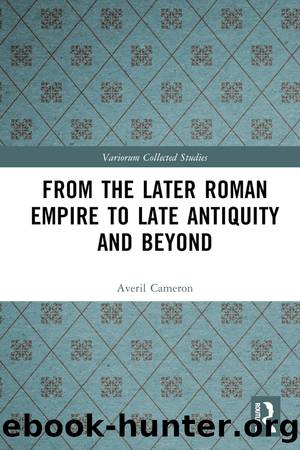From the Later Roman Empire to Late Antiquity and Beyond by Averil Cameron;

Author:Averil Cameron;
Language: eng
Format: epub
Publisher: Taylor & Francis (Unlimited)
Published: 2023-06-15T00:00:00+00:00
A few years later, in 1985, I was pleased to be able to invite him to lecture at Kingâs College London, where he gave his paper on Macrina, the sister of Gregory of Nyssa and Basil of Caesarea known to us through the hagiographical Life written by her brother Gregory. He was clearly drawn to the topic by his interest in biography and by the intriguing question of womenâs roles in the Christian life of the period. Yet his earlier ideas remained strong. He did not pursue the topic of Christian asceticism in any detail and this late paper makes it clear that he retained his essentially social view of the rise of Christianity. 7 He placed the Life in the context of the other works of Gregory of Nyssa (he found it âeccentricâ) and took the opportunity to reflect on the role of the aristocracy in the process of Christianization.
5 Cameron 1982. 6 Letter to Averil Cameron, 1 March 1982. 7 Momigliano 1985, 1987; see Cracco Ruggini 1989, 181; Marcone 2006, 231. Momigliano also lectured at Chicago in 1985 on âMen and Women in Roman Religionâ. He had more than once in earlier writings likened Christians to Cynics, in the context of resistance to authority. In the early 1940s Momigliano had written of himself that âfor the history of Christian thought in the third century AD the writer has not yet had sufficient preparation. He intends to reach itâ, and âI have not yet sufficient acquaintance with the Greek Fathers of the third and fourth centuries ADâ. 8 He did not in fact write a great deal that was about Christianity. 9 The preface to On Pagans, Jews and Christians, dated December 1986 [and therefore not long before his death], refers to the treble tradition which he had inherited as an Italian â Judaism, Hellenism and Christianity 10 â but it is striking that the collection itself contains far more about both pagans and Jews than it does about Christians. The Warburg lectures of 1958â59 on which The Conflict Between Christianity and Paganism was based [chapter 7 above] had brought to London an array of European scholars including H.-I. Marrou, who were already occupied with what we now call late antiquity, 11 and inevitably therefore with what it meant that the empire became Christian. The lectures were not Momiglianoâs own initiative; he had not even heard them all, and while he quickly accepted the invitation of his friend the director, Gertrud Bing, to edit them, John North and the publication of the letters between Momigliano and Bing warn us against laying too much emphasis on the 1963 volume as such.
8 Di Donato 1995, 223. 9 Marcone 2006, 225, also remarks that he did not address directly the great Christian figures of late antiquity. His interest in the apocryphal correspondence between Seneca and St Paul (Momigliano 1950, 1985) reflected a long interest in Seneca, on whom he had originally planned a book for Oxford University Press: see Murray 1988, 427; Di Donato 2007.
Download
This site does not store any files on its server. We only index and link to content provided by other sites. Please contact the content providers to delete copyright contents if any and email us, we'll remove relevant links or contents immediately.
Patriot by Alexei Navalny(348)
Museum of Antiquity by T. L. (Thomas Louis) Haines(286)
The Story of Joan of Arc by Andrew Lang(272)
2,2-Dimethyl-3,4-dihydro-2H-1,4-benzoxazines as isosteres of 2,2-dimethylchromans acting as inhibitors of insulin release and vascular smooth muscle relaxants by Bernard Pirotte & Xavier Florence & Eric Goffin & Philippe Lebrun(253)
The Apollo Moon Missions by Randy Walsh(244)
Richard III and the Princes in the Tower by A.J. Pollard(240)
The Memoirs of Pere Labat, 1693-1705 by Jean Baptiste(239)
Fry The Brain: The Art of Urban Sniping and its Role in Modern Guerrilla Warfare by John West(205)
A History of the Peninsular War, Vol. 5, Oct. 1811-Aug. 31, 1812 by Charles Oman(188)
The Memoirs of Count Grammont â Complete by Hamilton Anthony Count Walter Scott(183)
Life of Napoleon Bonaparte, Volume I. by Walter Scott(182)
1916 - The Battle of the Five Empires: 15 May - 28 September 1916 by Benoît Chenu(181)
Maleficium: Witchcraft and Witch Hunting in the West by Gordon Napier(175)
Rasputin the Rascal Monk by William Le Queux(171)
Famous Fights of Indian Native Regiments by Reginald Hodder(167)
BY MARK Twain, Twain - The innocents at home by 1881(157)
Father Browne's Titanic Album by E. E. O'Donnell(156)
The Thoughts of Marcus Aurelius by Marcus Aurelius(153)
Joanna of Flanders by Julie Sarpy(140)
